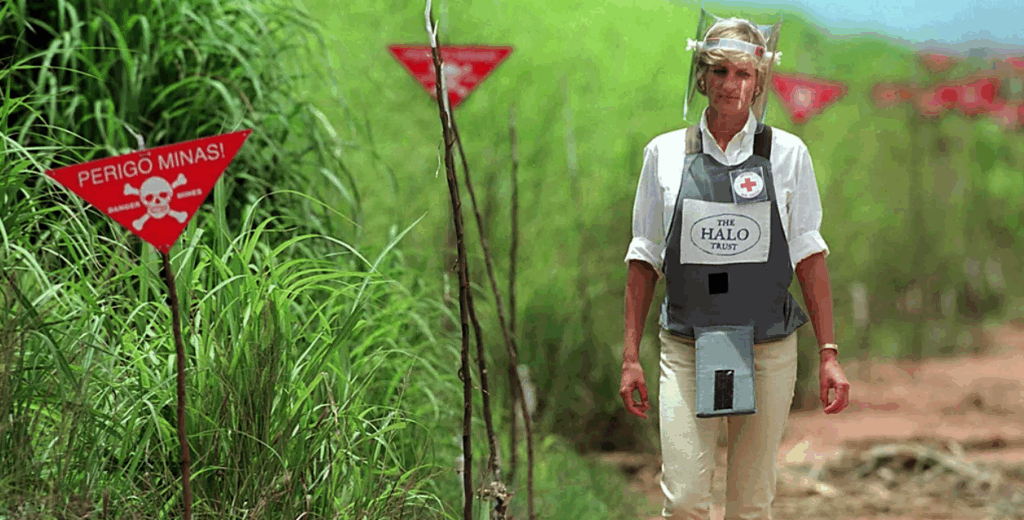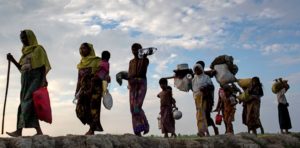
Princess Diana in a land mine field in Huanbo, Angola. January 1997. Source: Mirrorpix.
1997 – A year to remember
Princess Diana had a big impact on the adoption of the Ottawa Treaty banning anti-personnel (AP) mines. It had a lot to do with timing.
On 15 January 1997, Diana visited a mine clearance project in Angola. The photograph of her in a Halo Trust protective vest walking in the minefield was seen around the world.
That picture, her quiet campaigning, and her visit to minefields in Bosnia just a few weeks before her death in August 1997, helped to sustain the momentum that led to the adoption of the Anti-Personnel Mine Ban Treaty in Ottawa in December the same year.
When the picture was published, Diana was quoted as saying she hoped that the mines that mutilate children would be banned. She was publicly criticized by members of the British Conservative government of the time for speaking against British government policy, which was to retain the mines. The Labour opposition seized the opportunity to attack the government and speak against the use of mines.
On 1 May 1997, the Conservatives were defeated at a general election by Tony Blair’s Labour party. In accordance with its campaign commitment, the new government over-ruled the objections of some military officers and agreed to sign up to the mine ban treaty.
Britain was then joined by France. There, with President Chirac having just dissolved the National Assembly, Prime Minister Lionel Jospin, a personal supporter of the ban, also agreed that France should sign. The decision by these two European permanent members of the UN Security Council encouraged other European governments, notably Germany, to do the same.
Diana’s endorsement and the last minute change of policy in Britain and France also had a strong influence on countries in Africa and within the Commonwealth and beyond. Without all this, the effort to adopt the treaty could well have failed. Today, a total of 164 countries have ratified the treaty, although this does not include China, Russia or the USA.
A Father’s Grief
My own involvement in the effort against landmines had begun some seven years earlier when I was responsible for the UN’s cross-border programme of humanitarian aid from Pakistan to Afghanistan.
Visiting a stark cold hospital ward in Kabul in mid-winter, I looked into the eyes of an Afghan father sitting beside his child, who was lying, very pale, with one leg missing, on a hospital bed. I was witnessing an individual human tragedy, but I knew then that the family would represent for me the countless numbers of silent
victims of these terrible weapons.
Widespread compliance with the Treaty has brought down the annual number of deaths from a minimum of 26,000 in 1999, according to estimates by the six original members of the International Campaign to Ban Landmines (ICBL), to between 4,000 and 6,000 in the early 2020s, as recorded by Landmine Monitor. In light of this stunning achievement, how should one react to the news that Estonia, Finland, Latvia, Lithuania and Poland plan to withdraw from this remarkable example of modern international law? Astonishment, horror and sadness are what I feel.
Cheap and indiscriminate
The use of very large numbers of anti-personnel mines was a feature of conflicts in the late 1970s and 1980s in Afghanistan, Angola, Cambodia and Mozambique. The weapons were cheap to make, easy to use and required no maintenance. What makes them so appalling is that they are triggered by the victim and they remain active for years after being laid. Long after all the soldiers have left, the mines continue to kill and maim farmers, their children and their livestock.
The Soviet forces in Afghanistan used them both as perimeter protection for small fixed military positions and in the form of huge belts of mines around major towns. They also made large numbers available to the governments or resistance groups they supported in different parts of the world.
The Mine Ban Treaty
The story of the movement that resulted in 1997 in the adoption of an international treaty to ban anti-personnel landmines (the “Ottawa Convention”) is described by my friend Jean-Baptiste Richardier in his companion blog , “Back to the Killing Fields”. He writes from the perspective of someone intimately involved in the Nobel Prize winning campaign. The Convention received strong early support from a core group of States, including Angola, Austria, Belgium, Bosnia and Herzegovina, Canada, Germany, Ireland, Mexico, the Netherlands, Nicaragua, Norway, the Philippines, South Africa, and Switzerland. This group, along with the ICBL and the International Committee of the Red Cross (ICRC) and its President, Cornelio Sommaruga, and personalities such as Queen Noor of Jordan, played crucial roles in the treaty’s adoption.
Campaigning and remedial action
From the start, Diana had appreciated, as she did for the HIV/AIDS epidemic, that campaigning needs to go alongside practical programmes of remedial action. She was followed in this approach by her sons, the princes William and Harry and their association with two British NGOs, the Halo Trust and the Mines Advisory Group (MAG).
A Collaborative Effort
My own involvement, from the UN side, was to initiate the programmes of survey, clearance and mine risk education in Afghanistan in the 1990s, oversee the UN’s support for mine action in Bosnia from 1996 to 1998, and then, from 2000 to 2005, to serve as Director of the UN Mine Action Service (UNMAS).
In our efforts at UNMAS to coordinate support for this complex and herculean effort. the task was to marry the campaigning brilliance of the NGOs in ICBL with the diplomatic resources of the UN, and the professional and technical contributions of a wide range of partners. These included the Geneva International Centre for Humanitarian Demining (GICHD), the donor governments and the young people in the affected countries, working for NGOs or private companies, who enthusiastically undertake the painstaking work of finding, removing and destroying the mines.
A feature of the early UN-supported mine action programmes was the pre-eminent role of indigenous capacity in the affected countries. In Afghanistan, the UN supported six specialist mine action NGOs, all established and led by Afghan nationals. Only later, when international NGOs appeared, did donors begin to transfer their support to them.
Pride in service to community
As the programme of mine clearance in Afghanistan picked up speed in the 1990s and the total number of deminers employed by the Afghan clearance organisations rose above 7,000, stories began to circulate that families looking for a suitable match for their daughters were looking more favourably on the young deminers than on soldiers fighting for one of the Mujahideen groups. Communities appreciated the deminers’ work.
Having an impact
One of the many examples of collaboration between the UN and its partners was the Landmine Impact Surveys.
Organised by the Survey Action Centre and carried out by specialist NGOs, these surveys helped to turn daunting vistas of endless mine clearance projects into manageable chunks of priority work. The first of these surveys, for Yemen, was completed just as I joined UNMAS in 2000. It would not be an exaggeration to say that the impact surveys revolutionized the mine action sector. Even if the surveys had to use information that was sometimes not completely reliable, the results provided a much improved basis for setting priorities and allocating resources. Landmine impact surveys were completed in Cambodia and Mozambique in 2002, in Bosnia and Lebanon in 2004, in Afghanistan in 200, and in Angola in 2007.
No Going Back
The tremendous success of the Treaty and related demining work has saved lives and offered families and communities the prospect of new, peaceful and worthwhile lives. The threat of withdrawal from the Treaty by the five European states puts this prospect in jeopardy. Future generations in other parts of the world may have to confront the same horror that I witnessed in that cold hospital ward in Kabul.
It is not too late for the five countries to think again. They should look urgently at the evidence. Many military commanders have confirmed that anti-personnel landmines have never frustrated the advance of a determined enemy. Often, there are more victims among the soldiers laying the mines than among their enemies. There are plenty of ways for modern electronic equipment to detect the advance of enemy forces and to stop them in their tracks. The use of weapons that lie in wait for children of future generations is not only cruel, it is immoral and unnecessary.
To help persuade the five countries to change their minds, please sign the appeal launched by Handicap International/Humanity and Inclusion.
For a more detailed account of mine action in Afghanistan, see Martin Barber, Blinded by Humanity, London, IB Tauris, 2015.
About the Author: Martin Barber is a co-founder of UAI and was Director of the United Nations Mine Action Service (UNMAS) between 2000 and 2005.
The opinions expressed in this blog are those of the author and do not necessarily represent the views of United Against Inhumanity (UAI).











